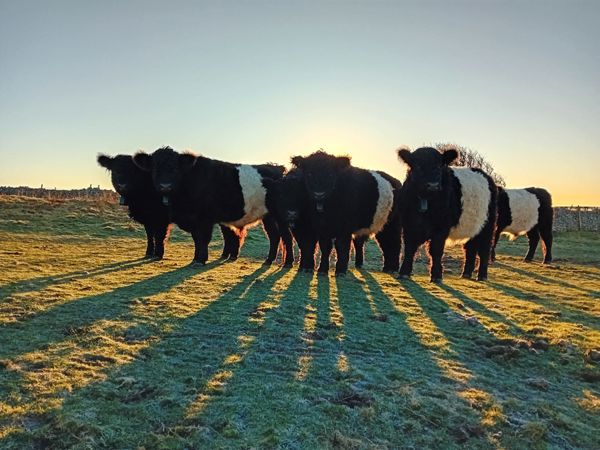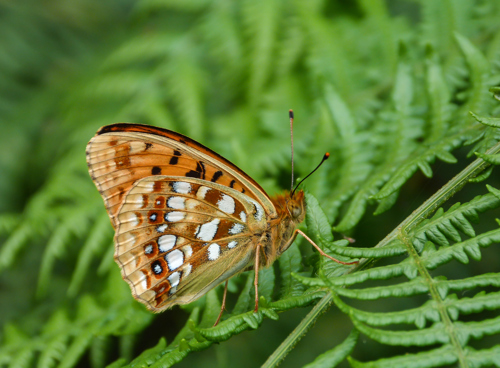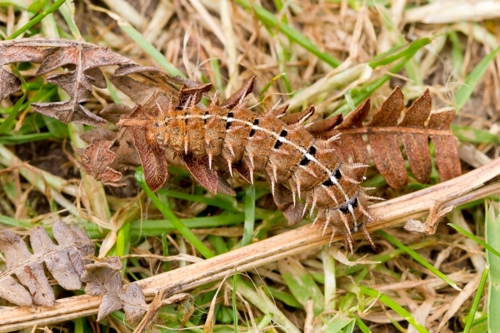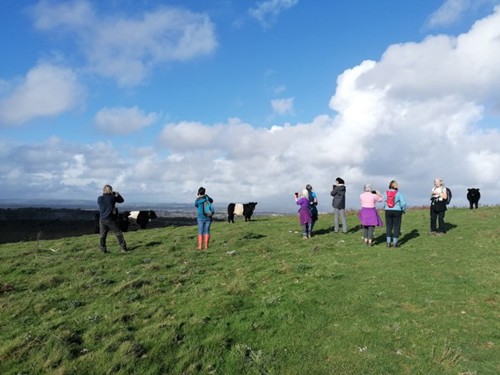What do the ‘Belties’ have to do with the rarest butterfly in Wales?

I am Andrea Rowe and I’m lucky enough to be one of the Project Officers working for Butterfly Conservation as part of the Natur am Byth! High Brown Fritillary project.
What on Earth is a ‘Beltie’ and what is a High Brown Fritillary?
Imagine it is the height of summer – one of those days where the air is still and warm and the sky is cloudless and blue. We are standing at Old Castle Down in the Vale of Glamorgan, listening to Skylarks sing as they ascend, surrounded by tall grasses, green Bracken and looking at the pinks and purples of thistle and bramble flowers. Then picture a flash of bright orange zoom past us and land. If we are lucky, we can gently edge a bit closer. There, perched enjoying the nectar, is a butterfly with the brightest orange upper wings with black dots and dashes and silvery spots underneath. This is the High Brown Fritillary – and this place is the only place the rarest butterfly in Wales can now be found.

High Brown Fritillary underwing ©Peter Eeles

High Brown Fritillary ©Iain Leach
But if we turn around, we will also find some other amazing creatures. Big and fluffy, black with white bands around their middles, staturesque and impressive, wearing some fancy collars. These are the ‘Belties’ or to give them their proper name: the Belted Galloways.
These cattle are an incredibly important part of our project.

Belted Galloway cattle ©Alan Sumnall
Let me tell you some more about our very special butterfly.
The High Brown Fritillary is what we call a ‘specialist’ - it has very specific habitat requirements that need to be met for it to survive and thrive. The opposite would be a ‘generalist’ species like the Meadow Brown, one of our most common butterflies, which can be found in lots of different habitats such as gardens, meadows, dunes and woodlands and whose caterpillars and adults will feed on a wide variety of plants.
The High Brown Fritillary life cycle never fails to amaze me. It spends most of the year as a tiny egg. At only around 8mm in size, they are incredibly difficult to spot. But like many butterfly eggs, they are works of art: tiny, conical sculptures with vertical ribs and horizontal struts which start off greenish-brown and change through pinkish-grey to grey in colour.

High Brown Fritillary butterfly eggs © Peter Eeles
The female butterfly lays her eggs, one at a time, in areas where Bracken and Common Dog Violets grow together in just the right balance. Many people think Bracken is awful for wildlife, but it’s absolutely essential for the High Brown Fritillary’s lifecycle. If the Bracken is too dense, the female won’t be able to lay her eggs and the layer of dead Bracken brash will be too thick and dense to allow the violets to grow. Too sparse and grasses will dominate, again preventing the violets from growing. But when the balance is just right, amazing things happen. The fronds and stems of the Bracken act a bit like a greenhouse does in your garden, creating a microclimate that can be 15° to 20°C higher than surrounding grassy areas.

Common dog violets flowering in Bracken © Andrea Rowe
The violets flourish in the warmth and in early March, when the weather can still be cold, a tiny 2mm long larva (the technical name for a caterpillar) emerges and starts eating. But there’s nothing varied about this caterpillar’s diet – it likes violets and nothing but violets. It then grows, moults, eats and grows and repeats! And if you thought the egg was hard to spot, you’d be amazed at the larva!

High Brown Fritillary larvae © Peter Eeles and Paul Dunn
After around 10 days, it has developed the most fantastic camouflage – a brown body with black flecks, a white stripe and spines that make it look just like the fronds of the dead Bracken it uses to bask on. I am looking forward to the challenge of finding them this year! The warmth of the Bracken helps the larva develop quickly. After 2 weeks and measuring around 40mm, the caterpillar is fully grown.
The last stage is the pupa, which is just as amazing to look at as the larva. It hangs upside down, pretending to be a shrivelled-up leaf for 2 to 3 weeks before the adult emerges to dazzle us.

High Brown Fritillary pupa © Paul Dunn
Stepping in to help maintain a balance
As you can tell, getting the habitat just right for the High Brown Fritillary is complicated. Unfortunately, this is why the butterfly has been lost from many of its’ former sites and is now only found in one place in Wales. Without any intervention, it is all too easy for Bracken to become too dense and species such as bramble and Gorse to dominate, and before you know it, the scrub has turned into woodland. That’s fine in some places; scrub and woodland are incredibly important habitats too. But in some places, like Old Castle Down, where species-rich grassland, heathland and Bracken mosaics support such a wealth of wildlife, we need to step in to help maintain a balance.
Luckily for the High Brown Fritillary, enough of a balance has been maintained at our project site to maintain some areas of suitable habitat. And that’s partly thanks to much of it being registered as Common Land.
What is Common Land?
Common Land has existed for a long time, firstly through the Magna Carta in 1215, to provide the poorest people in rural communities, who owned no land of their own, with ‘Rights of Common’ or ‘Commoners’ Rights’ – the right to use the land as a source of wood, bracken for bedding and pasture for livestock. Thanks to our local Commoners using their rights to graze the High Brown Fritillary has survived around Old Castle Down.
If the land has been grazed before, why are the Belties so important now?
In the past, many more commoners used their right to graze and, on Old Castle Down and the surrounding areas, a mix of cattle and sheep grazed the land. But over the years, the number of graziers has reduced and at the same time the Common land has become used by more and more people for recreation and the roads that cross the land have become busier and busier. This has all led to a reduction in the number and type of stock on site.
Reintroducing cattle grazing onto our site brings huge benefits but also some challenges such as ‘how do we keep the cattle safe without fences on Common land?’ and ‘will people be frightened?’
A virtual fence boundary
Luckily the solution to the first problem has been provided by technology and those fancy collars I mentioned. NoFence grazing lets the graziers plot a virtual fence boundary which is communicated to the GPS collar that the cattle wear via the mobile network. With a bit of training, the cattle learn to recognise an audible warning sound that lets them know where the virtual fence is. The fantastic thing about this technology is that the virtual fence can be moved very easily so we can target areas that need grazing and avoid areas that don’t – all without the need (and cost) of an actual fence.
As for peoples perception of the cattle, the Belties have been a great choice. They are well behaved, quiet and docile. They have been amazing around anyone who has joined us on a guided walk so far and are always happy to pose for a photo! As you can tell reading this, I have a big soft spot for this breed! They originally come from Galloway in Scotland and are often used for conservation grazing because they are very hardy. They have a long, coarse outer coat of hair and soft undercoat – great for keeping them warm and coping with rain (which this winter has been invaluable!) and it means they can stay on site during winter. They are also adapted for rough and steep grazing land and can utilize coarse grasses which other cattle breeds usually avoid - that’s really important as it means they are able to maintain good condition on our site (which is important to our farmers) while they do exactly what we need them to.

Smile! © Andrea Rowe
Cattle graze in very different ways to sheep
For a start they have much bigger mouths and use their big tongues to pull tufts of vegetation into their mouths. They pull up whatever vegetation is present where they are grazing and don’t target specific plants. This helps protect plant diversity. They also don’t graze vegetation too close to the ground, leaving a mosaic of tussocks and bare patches of ground. This provides a variety in the age and structure of the vegetation, which is very important for invertebrates, small mammals and ground-nesting birds. It also provides space for plants, including violets, to grow. And they use energy while they are grazing, which means that over time, soil fertility reduces – which is perfect for species rich habitats.
Due to their size, the Belties can also create their own access into rough areas and dense areas of Bracken – this helps control scrub (which they will also browse) and creates bare ground for invertebrates. They can access areas which are tricky to reach with machinery. Even when they are lying down, they can help – by crushing and bruising the Bracken naturally, which helps reduce growth and creates microclimates.

Bracken trampled by our Belties © Andrea Rowe
Let’s not forget the Cattle Dung
As an added bonus, their dung is really important too! The dung supports dung beetles and a wealth of invertebrates which in turn provide food for other species at our site such as Yellowhammers and Song Thrushes, bats and voles, which in turn provide food for Adders and owls.

Cattle dung ©Andrea Rowe
Want to get involved?
I am really looking forward to the start of our field season and getting out on site to survey for larvae and the adults later in the year.
If anyone fancies joining me, please get in touch!
